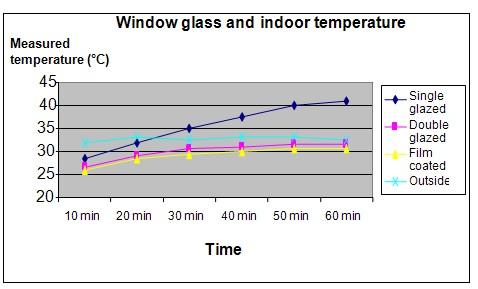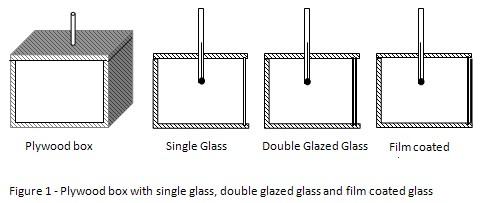| Complexity level: | 8 |
| Project cost ($): | 80 |
| Time required: | 2 days to prepare, 1 hour for the science project experiment |
| Material availability: | Easily found |
| Safety concerns: | None |
Hypothesis
Double-glazed glass and film-coated glass provide better thermal insulation compared to single-glazed glass windows.
Overview
Glass Window and thermal insulation
On hot sunny days, the light and heat coming through the glass window can raise indoor temperatures to very uncomfortable levels. This increase in temperature will neccessitate additional cooling - and higher electricity bills. Air.
The transparency of glass allows both the visible and ultra violet light to pass through it. When the light touches the surface, its energy is absorbed, reflected or scattered as heat. Since glass is a poor conductor of heat, the heat is trapped indoors and the room temperature increases creating a greenhouse effect.
Insulated or double-glazed glass consists of multiple glass panes assembled into a single unit. The gas or vacuum in between the glass panes will provide both thermal and acoustic insulation while still maintaining visual transparency. The use of film-coated or tinted single-glazed glass windows also provides better thermal insulation but the transparency of the glass is compromised.
Scientific Terms
Materials
The materials required for this science fair project:
- 4 thermometers
- A drill with appropriately sized bits
- A 1 x 1 x 1 meter plywood box fitted with a single-glazed glass window
- A 1 x 1 x 1 meter plywood box fitted with a double-glazed glass window
- A 1 x 1 x 1 meter plywood box fitted with a film-coated glass window
- A box of clay
Procedure
1. For this science fair project, the independent variable is the type of glass used – Single glazed, double glazed and film-coated single glass. The dependent variable is the temperature inside the wooden box. This is determined by measuring the temperature with a thermometer. The constants (control variables) are the size of the plywood box, the location of the thermometer, the amount of sunlight and the temperature outside.
2. Three plywood boxes are ordered from a local carpenter. The proposed size of the box is 1 x 1 x 1 meters as shown in figure 1 above. The top cover of the box should be removable so that the thermometer can be mounted. The first box is mounted with a single glazed glass window. The second box will have a double glazed glass window and the third box will have a film-coated single glazed glass window.
3. An electric drill is used to make a hole in the center of the top covers. The thermometers are mounted in the hole and clay is used to hold them.
4. The 3 plywood boxes are then brought outdoors and placed directly under the sun. The amount of sunlight received by the 3 boxes must be the same - there should not be any shade or trees blocking the sunlight.

5. The outdoor temperature and the temperatures inside the boxes are recorded every 10 minutes for the next 1 hour. The temperatures are recorded in the table given below.


Results
The double-glazed glass window and the film-coated glass window were able to provide better thermal insulation compared to the single-glazed glass window.
|
Type of glass window used |
Temperature measured inside the plywood box (°C) |
|||||
|
10 minutes |
20 minutes |
30 minutes |
40 minutes |
50 minutes |
60 minutes |
|
|
Single-glazed |
28.5 |
32.0 |
35.0 |
37.5 |
40.0 |
41.0 |
|
Double-glazed |
26.5 |
29.0 |
30.5 |
31.0 |
31.5 |
31.5 |
|
Film-coated |
26.0 |
28.5 |
29.5 |
30.0 |
30.5 |
30.5 |
|
Outside |
32.0 |
33.0 |
32.5 |
33.0 |
33.0 |
32.5 |
The graph below represents the results of our science project experiment.

Conclusion
Our hypothesis has been proven correct - double-glazed glass and film-coated glass provide better thermal insulation compared to single-glazed glass windows.
Glass windows provide better natural lighting but they also result in an increase of indoor temperatures. This will result in higher air conditioning costs. The heating that results from glass windows can also be reduced by planting trees near the windows, using fabric curtains or Venetian blinds.
Also consider
To improve the reliability and accuracy of our results, a larger sample of participants should be used.
This science fair project may be repeated, this time, with a thermal source like an incandescent lamp to compare the thermal insulation of single-glazed windows, double-glazed windows and film-coated glass.
Modify the science project experiment, evaluating glass of different thickness.
References
Insulated glazing - http://en.wikipedia.org/wiki/Insulated_glazing
How to reduce indoor heat gain from windows - http://www.ehow.com/how_12030_reduce-indoor-heat.html
Glass facts - http://www.gpwindowfilms.com/glass-facts.html

